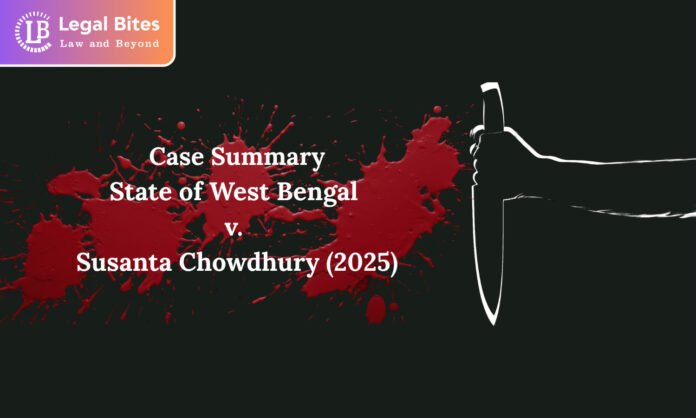This case stems from a heinous crime wherein the accused, Susanta Chowdhury, was convicted for the brutal murder of a young woman with whom he was formerly in a romantic relationship. The incident occurred on May 2, 2022, in Behrampore, Murshidabad. The trial court sentenced the accused to death under Section 302 IPC (Section 103 BNS) and Section 28 of the Arms Act, which was referred for confirmation to the Calcutta High Court. Alongside, the accused filed an appeal challenging the conviction and sentence. The High Court heard both matters analogously.
Case Title: State of West Bengal v. Susanta Chowdhury
Court: Calcutta High Court
Citation: CRA (DB) 349 of 2023
Bench: Justice Debangsu Basak, Justice Md. Shabbar Rashidi
Date of Judgment: June 11, 2025
Factual Background and Charges
The accused, aged around 21 at the time, had previously been in a relationship with the victim, a college student pursuing Zoology Honours. Following her distancing and developing a new relationship, he became vengeful and began harassing her, as evidenced by earlier complaints and witness testimonies. On May 2, 2022, the accused stabbed the victim 45 times on a public road outside her residence, brandishing a toy gun to prevent bystanders from intervening.
The police charged him under:
- Section 302 IPC (now Section 103 of BNS) for murder, and
- Section 28 of the Arms Act for using an imitation firearm to resist arrest.
Prosecution Case and Evidence
1. Eyewitnesses and Digital Footage
- PW 2, a journalist, witnessed the crime and recorded it on his mobile. His Section 65B certificate (now Section 63 of the Bharatiya Sakshya Adhiniyam) was submitted, and he identified the accused while corroborating the sequence of events.
- PW 3, a local shopkeeper, also witnessed the stabbing and attempted to intervene but was threatened with the toy gun.
Both witnesses were extensively cross-examined, but their testimonies remained consistent and credible.
2. Forensic and Medical Evidence
- PW 1, the post-mortem doctor, found 45 stab wounds, including defensive injuries, confirming a violent struggle.
- Forensic analysis confirmed that the knife and blood-stained clothing seized from the accused matched the victim’s DNA.
- CCTV footage and gait analysis were presented and confirmed the accused’s presence and movements at the scene.
3. Arrest and Seizure
The accused was apprehended during a Naka check, carrying a bloodied knife, a toy gun, and his blood-stained clothes. Seizure witnesses (PW 8, PW 15) and the driver (PW 26) corroborated the apprehension and recovery.
4. Relationship History and Motive
- Victim’s father (PW 16), sister (PW 9), and friend (PW 20) testified about repeated threats and harassment by the accused.
- PW 33, a local councillor, confirmed a community intervention meeting where the accused was warned to stay away.
Defence Case
The defence, led by senior counsel, argued:
- Unfair Trial: Failure to examine all witnesses present at the crime scene violated fair trial principles. The Court rejected this, citing that quality, not quantity of evidence matters.
- Digital Evidence Procedure: Non-compliance with Section 65B was raised, but the High Court found compliance sufficient.
- Gait Analysis Reliability: Dismissed by the Court, holding it as corroborative, not sole, evidence.
- Emotional Disturbance and Young Age: Argued as mitigating factors against the death penalty.
The accused claimed false implication and offered no defence evidence under Section 313 CrPC.
Trial Court Verdict
The Fast Track, Third Court, Behrampore, convicted the accused on August 29, 2023, and sentenced him to death on August 31, 2023. The case was then referred for confirmation to the Calcutta High Court.
High Court’s Analysis
1. Conviction Affirmed
The Court upheld the conviction, finding that:
- The testimonies of PW 2 and PW 3 were direct, credible, and corroborated by medical and forensic evidence.
- The accused was positively identified by multiple witnesses.
- Intent, preparation, and brutality were clearly established—use of a toy gun to deter intervention and 45 stab wounds demonstrated pre-meditation and depravity.
2. Consideration of the Death Penalty
The Court thoroughly applied the tests from:
- Bachan Singh v. State of Punjab (1980) – “Rarest of Rare” doctrine
- Machhi Singh v. State of Punjab (1983)
- Santosh Bariyar and Rajendra Wasnik – doctrine of proportionality and rehabilitation
- Swamy Shraddananda (2) and V. Sriharan – alternate sentencing models barring remission
3. Crime Test v. Criminal Test
| Test | High Court Observation |
|---|---|
| Crime Test (Aggravating) | Brutal murder, pre-meditation, resistance to intervention, 45 stab wounds. |
| Criminal Test (Mitigating) | No previous convictions, age (21), potential for reformation, suffering from depression. |
| Rarest of Rare | Not met. The Court found that although the crime was grave, it was not of the rarest category mandating death. |
Final Judgment
The High Court commuted the death sentence to:
- Life imprisonment without remission for 40 years from the date of arrest.
- Fine of ₹50,000, and in default, 5 years’ rigorous imprisonment.
- Sentence under Section 28 of the Arms Act was upheld.
- Sentences to run concurrently.
- Benefit under Section 428 CrPC (set-off of detention period) granted.
The Court held:
In our view, interest of justice would be subserved by commuting the death penalty to one of life imprisonment without the possibility of remission for another 40 years from the date of arrest of the appellant.
The Court emphasised reformation, youthfulness, and lack of prior convictions as significant mitigating factors, despite the gruesomeness of the act.
Conclusion
This judgment reaffirms the Indian judiciary’s cautious approach to awarding the death penalty. The Calcutta High Court struck a balance between retribution and reformation, aligning with evolving jurisprudence that the death penalty should only be awarded when life imprisonment is “unquestionably foreclosed.” While the crime was horrendous, the convict’s age, potential for reform, and medical history tipped the scale towards a strict but not fatal sentence.

